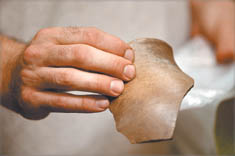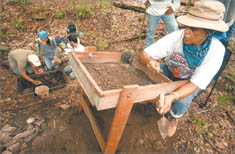
Digging Up Clues To The
Past
Tribe Members, Students Find
Evidence Of Pequot Households From 1700s
|
|
 |
| Buy
this Photo |
Tim Cook |
| Stephen
Silliman, a UMass anthropology professor, holds a
piece of stoneware discovered during the
dig. | |
 |
| Buy
this Photo |
Tim Cook |
| Eastern
Pequot tribe member Darlene Fonville, above right,
works with University of Massachusetts-Boston
anthropology students and members of the Eastern
Pequot tribe during an excavation of former tribal
lands on the Eastern Pequot reservation
Thursday. | | | By KAREN
FLORIN
Day Staff Writer,
Casinos/Gambling
Published on
8/9/2003
North Stonington— Eastern Pequot Darlene “Tubby” Fonville
found an arrowhead on the tribe's reservation last month and was
hooked on archeology.
Fonville and a few other tribal members got down in the dirt with
Stephen Silliman, a University of Massachusetts-Boston anthropology
professor, and his students this summer as they conducted an
archeological dig on the Eastern Pequots' 226-acre reservation. They
found evidence of Pequot households from the 1700s and some signs of
life before American Indians first had contact with Europeans,
Silliman said. The work likely will continue next summer.
“We're trying to look at the struggle and continuity of the
Eastern Pequots since the reservation was established in 1683,”
Silliman said. “To come to grips with how it played out in their
daily lives, what tools were used, what foods were eaten.”
Fonville, a cheerful, middle-aged woman who despite her nickname
is far from fat, found the arrowhead soon after the dig started. It
was the first of several artifacts the earth yielded and will be
analyzed along with the others to learn more about the people who
lived here over the centuries. Fonville's friends said she would
last just a couple of days in the woods, but she stuck it out, bugs,
humidity and all, and is ready to sign up for next summer's dig.
“The days went by and it got more interesting,” Fonville said.
“We found a lot of stuff: coins, buttons, pottery. I learned a lot
being out here.”
She was sitting at a dig site deep in the woods Thursday
afternoon, wearing dog collars for fleas and ticks around her
ankles, listening to a Walkman and singing softly as she sifted
through a pile of soil. She came up with several small pieces of
clay and glass. Nearby, a few students worked in a square hole,
preparing to excavate what looked like a larger piece of red
pottery.
Silliman said that in the past 10 to 15 years, archeologists have
had more opportunity to work with native people and to get their
input. Before, he said, it was just the archeologists telling the
natives what they had found.
Tribal member Bobby Sebastian, who lives on the reservation, is
serving as historic preservation officer. He has walked and hunted
the hilly, rocky woodlands for years, and helped the crew pinpoint
areas of interest. He said he sprinkled ceremonial tobacco on sites
after the students finished, as an offering of thanks to the
Creator. Tribal elder Norma Parrish, 79, joined the dig from time to
time, impressing the younger people with her speed and agility in
the woods.
“It's so exciting to walk the lands and just to explore and find
out these things,” she said.
Tribal Councilor Katherine Sebastian said the University of
Massachusetts' anthropology department would serve as temporary
curator until the tribe has a place to exhibit its artifacts.
Sebastian brought some samples and pictures from the dig to a recent
council meeting and said they generated “a lot of interest.”
The Eastern Pequot dig, the first scientific survey on the
reservation, is one of at least three that took place on local
Indian reservations this summer. Students from the University of
Connecticut conducted a dig on the Mashantucket Pequots' reservation
under the guidance of Kevin McBride, a professor and the research
director of the tribe's museum. They explored dwelling sites to
learn more about their occupants.
At Mohegan, 14 students from seven universities took part in a
dig at Fort Shantok as part of the Eastern Connecticut State
University archeological field school program. They helped locate a
burial ground using ground-penetrating radar.
•••••••
Back on the Eastern Pequot reservation Thursday, Silliman
explained how archeologists start with a broad survey of a site then
narrow their focus. The first step at the Eastern reservation was a
“pedestrian survey,” in which people line up at intervals with
compasses and head into the woods looking for points of interest.
They used a grid system to ensure they weren't biased toward any
particular areas and trudged through swamps and thickly wooded areas
so as not to miss anything.
Bobby Sebastian led them to some gravesites and other landmarks,
and they chose other areas that looked promising
The next step was a “sub-surface survey.” At points of interest
–– near stone walls or animal pens –– the crew dug 225 test holes a
half-meter square to see what they would yield –– “to understand how
things are distributed and to start to narrow down where exactly
people might have done things,” Silliman said.
“You're actually digging in people's garbage –– what they threw
away,” he said.
They returned to the most promising sites and dug larger holes
for a more thorough excavation. Silliman showed a few items they
pulled from the earth, bagged and readied for laboratory analysis: a
cow's tooth, a clam shell, a piece of plate with a deep blue edge
that appeared to have come from England during the 1800s, stoneware
and a pipe stem. One of the easiest items to analyze was a rubber
button marked “Goodyear 1851.”
k.florin@theday.com 
© The Day Publishing Co., 2004
For home
delivery, please call 1-800-542-3354 Ext.
4700 |